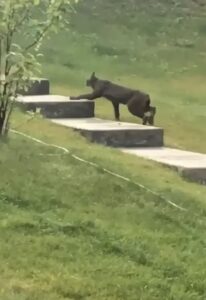A species of lynx native to North America, including Canada and parts of the United States, is called the Canada Lynx, or Lynx canadensis.
Although the Canada Lynx normally has a light brownish-gray fur coat, there have been reports of black-furred individuals as well.
Black-colored type had never been photographed, but in 2022, a lucky person was able to snaap some images that quickly went viral.
The animal was caught by a researcher at the University of Alberta, Canada. Thomas Jung, an employee of the Government of Yukon, recorded a video of the animal on his cell phone.
The discovery was documented in an article, “Paint it black: first record of melanism in Canada lynx (Lynx canadensis),” in the journal Mammalia.
The footage was captured in a rural residential neighborhood close to the Yukon metropolis of Whitehorse. The lynx may be seen in the video relaxing at a distance of roughly 50 meters. There were some people and a dog nearby, and the lynx eventually fled when the dog began to bark.
The behaviour of the Canada Lynx is that of a lone, reclusive creature.Although they were able to identify the animal as a Canada lynx, experts on the species were unable to make out many distinguishing traits in the shaky video.

”It had a black coat containing whitish gray guard hairs throughout, as well as whitish gray hairs in the facial ruff and the rostrum and dorsal regions,” Jung reports.
The majority of lynx species have similar coloring, with winter sightings of Canada lynx being prevalent due to their silvery gray coats. Their coats frequently turn reddish brown in the summer.
The lynx in the movie is a very rare species because of its wide range of coat colors.According to Jung, variations like these are frequently adaptations that may be helpful (adaptive) or harmful (maladaptive) to evolution.
Melanism in any animal has not yet been proven to be advantageous or disadvantageous by scientists. However, Jung considers the lynx’s feature to be maladaptive because it results in a lack of essential camouflage. The animal would probably stand out in the snow while hunting in the winter because of its darker hair.





